
Antetic AI, inspired by ant colonies, emphasizes distributed intelligence, emergent behavior, and decentralized decision-making. Its strengths lie in scalability, robustness, adaptability, and optimization.
Antetic AI

The path to Artificial General Intelligence (AGI) lies in replicating the "evolutionary kernel" of human learning – our innate predispositions and evolutionarily shaped biases. This involves endowing AI with genetically inspired core concepts (akin to an "AI genome"), implementing cultural transmission mechanisms for learning through observation, shaping curiosity with evolutionary rewards and pressures, and enabling transfer learning and analogical reasoning for adaptability. Although computationally expensive and ethically complex, mimicking natural intelligence is crucial for creating resilient, adaptable, and collaborative AI systems. Read more.
The "AntGI" hypothesis proposes that understanding the simpler, yet effective, intelligence of ant colonies offers a faster route to Artificial General Intelligence (AGI) than solely mimicking the human brain. AntGI aims to uncover fundamental algorithms and evolutionary principles by comprehensively understanding the mechanisms that allow ant colonies to solve complex problems (Dynamic Foraging and Resource Optimization; Decentralized Decision-Making and Task Allocation; Complex Nest Construction and Environmental Engineering; Social Immunity and Disease Management; Learning and Adaptation to Novel Environments; Sophisticated Communication Through Chemical Signaling). The methodology involves agent-based modeling, bio-inspired algorithm development, robotic emulation, neuroscience studies, mathematical modeling, and evolutionary computation. By focusing on the evolutionary foundations of intelligence, AntGI aims to enhance robustness, energy efficiency, and explainability in AI, while unlocking new learning paradigms and accelerating the path to AGI. It advocates for extracting fundamental principles from ant intelligence, rather than just mimicking behavior, for a more biologically plausible approach to AGI. Read more.
_gif.gif)
_gif.gif)
Current "agentic" AIs, touted as autonomous entities, may be more like complex ant colonies ("Antetic") than truly independent agents. These AIs often use modular architectures where tasks are broken down and assigned to specialized tools (like ants with foraging duties). Techniques like Chain-of-Thought and Reflexion act as stigmergy, guiding the AI's actions, while LLMs serve as communication mechanisms ("pheromone trails") between modules. These AIs lack integrated self-awareness and often require significant upfront human priming. This raises the question: is their apparent agency an illusion created by pre-programmed systems? Recognizing this "Antetic" nature is crucial for risk mitigation, improving explainability, and focusing future research on creating genuinely autonomous AI with integrated reasoning. We need to deeply analyze the underlying architectures and carefully consider the degree to which they truly embody the principles of autonomy, proactiveness, and rationality that define genuine agency. Read more.
Antetic AI, inspired by ant colonies, emphasizes distributed intelligence, emergent behavior, and decentralized decision-making. Its strengths lie in scalability, robustness, adaptability, and optimization, but it lacks individual creativity and can face communication challenges. Agentic AI, conversely, focuses on creating individual, autonomous agents capable of independent thought, reasoning, and action. Its strengths are individual creativity, complex reasoning, and proactive behavior, but it faces complexity, scalability, and coordination issues. The future of AI may involve a convergence of these approaches, combining the strengths of both for hybrid systems. Both approaches face challenges: controlling emergent behavior in Antetic AI and achieving true autonomy and ethical behavior in Agentic AI. Read more.
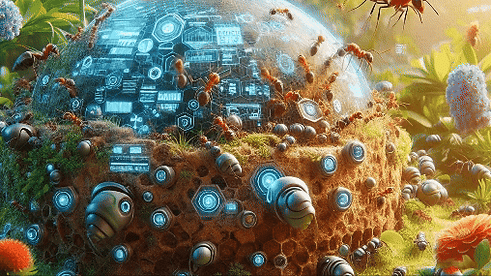_gif.gif)
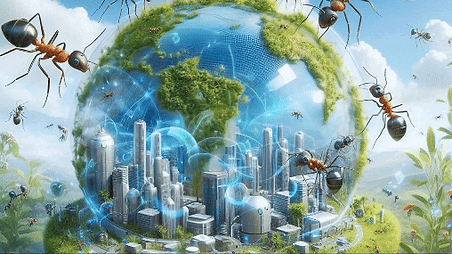_gif.gif)
Antetic AI's core principle is emergence: complex behavior arising from simple agents' interactions, making the whole more capable than the sum of its parts. Examples include optimal pathfinding via pheromone trails, dynamic task allocation responding to colony needs, complex nest construction guided by local cues, collective nest site selection through scout ant communication, and self-organized sorting/clustering. Factors influencing emergence include agent complexity, interaction rules, environmental factors, feedback mechanisms, and the number of agents. This leads to robustness, adaptability, scalability, and simplicity. Challenges include unpredictability, controlling emergent behavior, and explainability. Future research focuses on sophisticated agent models, new interaction rules, diverse applications, visualization tools, and a deeper theoretical understanding of emergence, to unlock the power of collective intelligence. Read more.
Multi-Agent Systems (MAS) often fail due to poor task specification, inter-agent misalignment, and inadequate verification. Antetic AI, inspired by ant colonies, offers a solution through decentralization, stigmergic communication, robustness, and emergent problem-solving. It addresses MAS failures by minimizing explicit task specification, reducing communication risks, and providing inherent redundancy for task verification. Specific techniques include pheromone-based task allocation, swarm robotics for collaborative construction, stigmergic information sharing, and distributed optimization algorithms. This leads to increased robustness, enhanced adaptability, improved scalability, and reduced complexity in MAS. Antetic principles can transform fragmented MAS into thriving "colonies" of intelligent agents, capable of tackling complex challenges with efficiency and resilience. Read more.
_gif.gif)
_gif.gif)
Antetic AI and Complex Systems Theory are deeply intertwined. Complex Systems Theory provides tools to understand emergence, self-organization, and feedback loops in Antetic AI, where ant behavior embodies these principles. Examples include foraging strategies, nest construction, and task allocation emerging from local interactions. Applying Complex Systems Theory aids in understanding, predicting, controlling, and optimizing Antetic AI systems, designing robust systems, and identifying key parameters. Techniques include modeling pheromone dynamics, agent-based modeling, network analysis, and sensitivity analysis. Challenges involve modeling complexity, data requirements, and computational cost. The symbiotic relationship unlocks AI that adapts, learns, and thrives in complex environments, requiring an interdisciplinary approach. Read more.
Stigmergy, a form of indirect communication where agents modify their environment to influence others, is key to Antetic AI. Unlike direct communication, it relies on agents leaving traces that act as cues. A classic example is pheromone trails in ant colonies. Key characteristics include indirect communication, environmental modification, the environment as memory, emergent coordination, scalability, and robustness. Antetic AI leverages stigmergy for pheromone-inspired path planning, stigmergic task allocation, collaborative construction with digital blocks, swarm-based data clustering, and Chain-of-Thought reasoning with a shared knowledge graph. Challenges include designing effective environmental modifications, managing complexity, balancing exploration and exploitation, and integrating individual learning. Future research will focus on more sophisticated mechanisms, individual learning, and diverse applications. Read more.
_gif.gif)
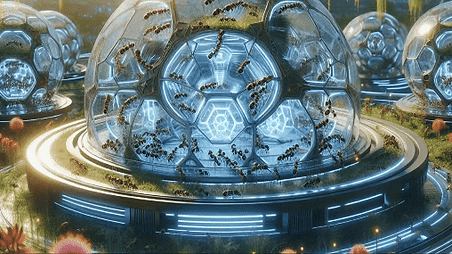_gif.gif)
Resilience is paramount in AI systems, and Antetic AI, inspired by ant colonies, offers a fault-tolerant and self-healing approach. Ant colonies achieve this through decentralized control, redundancy, adaptive communication, and self-organization. Antetic AI incorporates mechanisms like redundancy and task replication, decentralized task allocation, stigmergic communication, agent monitoring, adaptive behavior through learning, modular design, and environment-based self-repair. Examples include swarm robotics for search and rescue, distributed computing, and sensor networks. Challenges include design complexity, performance-robustness trade-offs, scalability, and verification. Future research will focus on sophisticated detection mechanisms, efficient reallocation algorithms, integrating learning, and developing theoretical frameworks. The goal is to build enduring AI systems that thrive in the face of adversity, mimicking the resilience of ant colonies. Read more.
While often seen as detrimental, noise and randomness can be powerful in Antetic AI by breaking symmetry, enhancing exploration, promoting robustness, and facilitating adaptation. Ant colonies incorporate noise through random foraging, probabilistic decision-making, and genetic variation. Antetic AI systems can leverage this through random walks in path planning, noisy activation functions in neural networks, random task allocation in swarm robotics, stochastic pheromone deposition, and mutation in evolutionary algorithms. Tuning the intensity of noise is crucial, and can be achieved through parameter optimization, adaptive noise injection, and experimental analysis. Future research focuses on theoretical understanding, adaptive noise control, hybrid approaches, and new applications. By embracing imperfection, Antetic AI can unlock new possibilities and achieve greater performance. Read more.
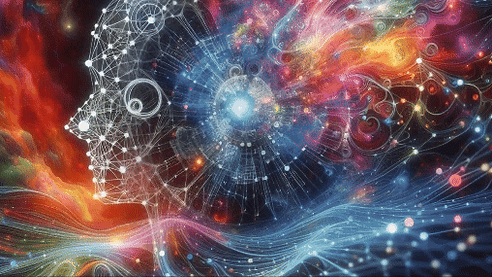_gif.gif)
_gif.gif)
Antetic AI distributes intelligence across interacting agents, requiring consideration of agent models, environment, communication mechanisms, task allocation, learning, and control. Architectural approaches include purely decentralized (high robustness, challenging to control), hierarchical (improved control, less robust), hybrid (balances benefits), environment-centric (maximizes stigmergy), and knowledge-based (improves efficiency in complex environments). The choice depends on task complexity, environmental dynamics, resource constraints, and design goals. Challenges involve formal design principles, creating tools and frameworks, exploring new approaches, developing performance metrics, and bridging the theory-practice gap. Architectural diversity is key for addressing diverse challenges. Read more.
Traditional agency, based on individual autonomy, intentionality, rationality, and responsibility, falters in Antetic AI where intelligence is distributed. There's a loss of centralized control, blurred intentionality, distributed responsibility, and emergent behavior. Reframing agency requires recognizing emergent agency, shared intentionality through environmental goals, distributed responsibility based on contribution, and accountability frameworks centered on system-level governance. Specific approaches include holistic system design, agent-level constraints with system-level oversight, transparency centered on collective outcomes, collective monitoring, and formal frameworks for distributed liability. This shift has implications for ethics, requiring frameworks focused on system-level impact, legal frameworks addressing collective responsibility, and public education centered on system-level understanding. Embracing collective action ensures Antetic AI is responsible and aligned with human values through ethically-informed system design. Read more.
_gif.gif)
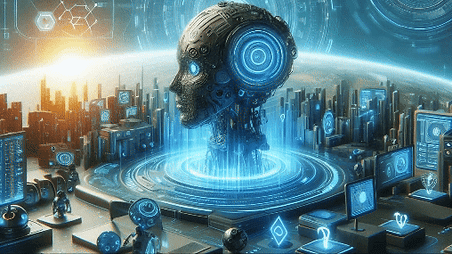_gif.gif)
Realizing sophisticated Antetic AI requires a specialized "Anthill Operating System" (Anthill OS) to address the limitations of general-purpose OSs (resource overhead, process management, communication infrastructure, real-time capabilities, lack of AI-specific abstractions). Anthill OS features a lightweight kernel, agent-centric design, scalable communication, real-time support, AI-specific abstractions, and hardware acceleration. Core components include a lightweight agent container, swarm communication layer, environmental interface, resource management system, AI services library, and security/isolation layer. Architectural considerations include microkernel vs. monolithic kernel, programming language choice, and hardware platform. Anthill OS improves performance, reduces resource consumption, simplifies development, enhances security, and provides greater flexibility. Challenges include developing a robust OS, maintaining compatibility, community adoption, integration with AI frameworks, and power-aware design. Read more.
"City Scavengers" proposes an Antetic AI ecosystem for proactive urban cleaning and maintenance, overcoming limitations of traditional methods through continuous, adaptive, and intelligent services. It comprises AI Ants (robotic agents with sensors, actuators, and behavioral rules), the Urban Environment (charging infrastructure, waste disposal, environmental sensors, a pheromone layer, and AR guidance), Anthill OS (orchestration engine for agent management, communication, data fusion, task allocation, and emergency coordination), and a Human Oversight System (monitoring dashboard, remote control, task prioritization, and data analysis). It operates through proactive exploration, stigmergic communication, dynamic task allocation, collaborative problem-solving, adaptive learning, and continuous monitoring. The benefits include improved cleanliness, reduced maintenance costs, increased efficiency, enhanced sustainability, and data-driven decision-making. Challenges include robustness, sensor accuracy, data security, ethical considerations, scalability, AI explainability, and integration with smart city initiatives. Read more.
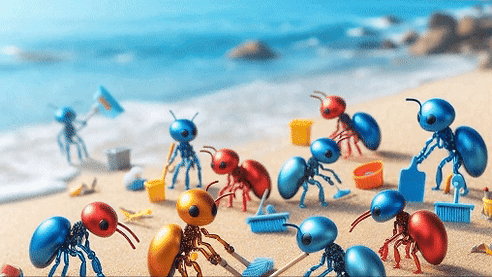_gif.gif)
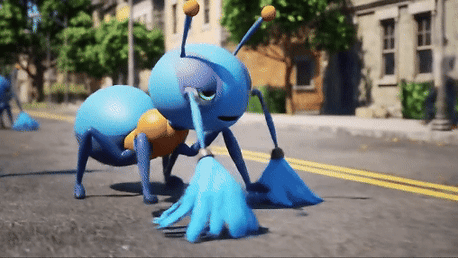_gif.gif)
"City Scavengers" concept, powered by Antetic AI and the Anthill OS, can be used to proactively address urban decay and prevent crime, drawing on the "broken windows theory." City Scavengers would use AI-powered "ants" to constantly monitor public spaces, promptly clean up litter and graffiti, and report infrastructure damage. This continuous maintenance signals care and order, deterring crime and fostering community pride. The article highlights the benefits of this approach, including efficiency, data-driven decision making, and avoiding potentially discriminatory policing practices. It also emphasizes the importance of integrating community engagement, like citizen reporting apps, and addresses challenges such as robot design, data privacy, and potential job displacement. Ultimately, City Scavengers aims to create a thriving urban ecosystem by fostering a shared commitment to maintaining and improving communities. Read more.
Antetic AI, a field inspired by self-assembly processes in ant colonies, aiming to create artificial systems that can autonomously construct complex structures. Self-assembly, where individual components organize without external direction, is contrasted with traditional manufacturing. Antetic AI mimics natural examples like protein folding and ant nest construction through decentralized control, local interactions, environmental sensing, self-organization, stigmergy, and fault tolerance. Mechanisms for self-assembly include shape-, chemical-, force-, energy-, and rule-based approaches. The article highlights applications in modular robotics, adaptive manufacturing, distributed sensor networks, and deployable structures for space exploration, including in-situ resource utilization. Challenges include design complexity, scalability, robustness, verification, and material properties. Future research directions involve developing sophisticated algorithms, exploring new materials, improving robustness, and integrating self-assembly with other AI techniques. The article concludes that self-assembly in Antetic AI holds significant potential for creating more adaptable, robust, and efficient systems in various fields. Read more.
_gif.gif)
_gif.gif)
Deutsch's "Fallacies of Distributed Computing," common misconceptions in distributed system design, are particularly relevant to Antetic AI systems, which are inspired by decentralized ant colonies. These fallacies (like assuming reliable networks, zero latency, infinite bandwidth, etc.) can lead to flawed and inefficient Antetic AI architectures. The article breaks down each fallacy, explaining how it manifests in Antetic AI development with specific examples, and provides concrete strategies to avoid these pitfalls. By acknowledging and addressing these fallacies, developers can create more robust, scalable, adaptable, and ultimately more effective Antetic AI systems capable of handling real-world complexities and challenges. Read more.
The ARC-AGI-2 benchmark reveals a significant "human-AI gap," highlighting AI's struggles with skills humans acquire easily: symbolic reasoning, rule application, efficient learning, and contextual adaptation. Current AI, particularly LLMs, excels at pattern matching but lacks true understanding. Antetic AI, inspired by ant colony intelligence, and AntGI, focusing on evolutionary learning origins, offer an alternative. AntGI prioritizes discovering fundamental learning algorithms for efficiency and adaptability, while Antetic AI emphasizes emergent intelligence through simple agent interactions and stigmergy for contextual adaptation. This approach allows for distributed learning with minimal data and cost-efficiency. The article suggests a hybrid approach, combining LLMs with Antetic AI structures, embodied in robotics, could bridge the gap. It advocates for a paradigm shift towards foundational learning principles and emergent behavior to achieve true general intelligence. Read more.
_gif.gif)
_gif.gif)
Antetic AI, inspired by ant colony behavior, can revolutionize sanitation in India and globally. India's sanitation crisis is driven by rapid urbanization, inadequate infrastructure, and manual scavenging. "City Scavengers" (AI ants) would use sensors to identify and sort waste, dynamically optimize collection routes based on smart bin data, and integrate with existing waste management systems through the Anthill OS. The system promotes community engagement through mobile apps, gamification, and incentives for waste segregation. The strategy involves pilot projects, government partnerships, and a gradual, data-driven expansion. Challenges like cost, robustness, security, and social impact (job displacement) are acknowledged. The vision is a sustainable, circular economy where waste management is proactive, public health improves, and communities are empowered, starting in underserved areas and scaling globally. The importance of transitioning from a reactive approach to a self-sustaining system with waste-to-energy/material loops for financial viability is emphasized. Read more.
Traditional centralized AI systems, managed by a single controller, face limitations like single points of failure, bottlenecks, scalability issues, and lack of adaptability. Antetic AI, inspired by ant colonies, offers a decentralized alternative with autonomous agents. This distributed approach enhances robustness, scalability, and adaptability by enabling distributed decision-making, parallel processing, and autonomous learning. Techniques like dynamic task allocation and swarm intelligence algorithms are employed. Antetic AI excels in areas like robotics, sensor networks, and cybersecurity, offering a more resilient and adaptive approach compared to centralized systems. Read more.
_gif.gif)
_gif.gif)
Antetic AI utilizes decentralized task allocation strategies, inspired by ant colonies, to efficiently distribute work among numerous agents. This approach offers robustness, scalability, and adaptability compared to centralized systems. The article explores key strategies like stigmergy, market-based allocation, role-based allocation, and negotiation, alongside algorithms like ACO, PSO, and reinforcement learning. Performance depends on factors like agent capabilities, task characteristics, and environmental conditions. Current challenges include scalability, robustness, coordination, and adaptation. Future research focuses on developing more sophisticated algorithms, integrating AI techniques, exploring new applications, and creating standardized frameworks to unlock the full potential of Antetic AI. Read more.
The integration of Reinforcement Learning (RL) into Antetic AI, systems that use decentralized control and emergent behavior to achieve collective intelligence, is explored. RL, where agents learn through interaction with an environment by receiving rewards and penalties, complements Antetic AI by enabling adaptive behavior, decentralized learning, exploration, and handling uncertainty. Several strategies for integrating RL are outlined, including individual agent training, collective reward shaping, centralized training with decentralized execution, Multi-Agent RL (MARL), combining RL with stigmergy, and hierarchical RL. The challenges are also discussed, such as credit assignment, exploration-exploitation tradeoff, non-stationary environments, scalability, and reward signal design. Finally, potential future research directions and various applications of RL-enhanced Antetic AI are highlighted, including swarm robotics, resource management, search and rescue, data analysis, game playing, and urban cleaning, emphasizing the symbiotic relationship between RL and Antetic AI for creating more robust and adaptable AI systems. Read more.
_gif.gif)
_gif.gif)
Collective Reward Shaping in Antetic AI addresses the pitfalls of individual rewards, which can lead to resource depletion, free-riding, and competition. It advocates for reward functions that incentivize cooperation, altruism, and overall system success, based on principles like considering global performance, rewarding shared success, and ensuring fairness. Strategies include Team Reward, Proportional Reward, Difference Reward, Shapley Value, Successor Features, Global State Visibility, and Dynamic Reward Adjustment, each with benefits and drawbacks. Considerations for design involve task complexity, agent heterogeneity, communication constraints, and ethical implications. The goal is to foster cooperation and enable complex, scalable, and adaptable AI systems, with future research focusing on fairness and adaptability. Read more.
Cooperative Game Theory (CGT) provides a powerful framework for designing fair, efficient, and robust Antetic AI systems, where multiple agents work together. CGT concepts like the Shapley value, core, bargaining solutions, and Nucleolus can address key challenges in multi-agent systems, leading to fair resource allocation, stable coalition formation, incentive alignment, and resilience. Applications include fair task allocation using the Shapley value, stable team formation using the core, conflict resolution using bargaining solutions, and fair minimum resource allocation using Nucleolus. While challenges remain regarding computational complexity and dynamic environments, future research aims to improve algorithms and explore new applications in robotics, distributed computing, and social simulation. CGT promises to shape the future of AI swarms by promoting cooperation and equitable outcomes. Read more.


Traditional Antetic AI, relying on simple environmental cues for stigmergy, often overlooks the importance of internal states in individual agent decision-making. Internal State-Dependent Stigmergy (ISDS) addresses this by making both the deposition and perception of stigmergic cues dependent on an agent's internal state (e.g., energy level, motivation, memory, "emotional" states). This leads to more nuanced and adaptive coordination. Examples include risk-averse exploration after failure, resource allocation based on need, dynamic task specialization based on skill and fatigue, and context-aware communication based on internal models. ISDS offers increased adaptability, improved robustness, enhanced efficiency, and more realistic modeling of animal behavior. Challenges involve defining meaningful internal states, designing effective coupling mechanisms, managing complexity, verification/validation, and calibration of parameters. Future research will focus on better modeling and managing internal states, developing new linking mechanisms, creating visualization tools, and exploring ethical implications. ISDS represents a significant step towards creating emotionally intelligent swarms capable of more human-like collective behavior. Read more.
Antetic AI agents constantly face the exploration-exploitation tradeoff: exploring new options versus exploiting existing knowledge. Exploitation increases efficiency, reduces risk, and provides predictability, but can lead to stagnation. Exploration enables the discovery of superior solutions, adaptation to change, robustness to uncertainty, and improved generalization, but can also lead to inefficiency. Strategies for managing this tradeoff include epsilon-greedy exploration, Boltzmann exploration, Upper Confidence Bound (UCB) exploration, Thompson Sampling, social learning and imitation, age-based exploration, and Internal State-Dependent Stigmergy (ISDS) adjustments. The optimal balance depends on environmental dynamics, task complexity, agent capabilities, and communication costs. Key challenges involve developing more sophisticated and adaptive exploration strategies, integrating exploration with other AI techniques, quantifying the value of exploration, exploring diversity and heterogeneity, and creating adaptive learning rates. Mastering this tradeoff is essential for creating efficient and adaptable AI swarms capable of thriving in complex environments. Read more.


Individual learning in Antetic AI can be slow, highlighting the need for social learning and imitation, where agents learn by observing and copying others. Social learning accelerates learning, improves efficiency and robustness, enables emergent innovation, and reduces exploration costs. Mechanisms for implementing social learning include direct observation and imitation, pheromone-based imitation, role model selection, and indirect social learning. Challenges involve distinguishing good from bad information, balancing imitation with innovation, handling heterogeneity, preventing cheating, and ensuring diversity. Future research will focus on addressing these challenges, exploring the role of social networks, and combining social learning with other AI techniques. Applications include robotics, distributed computing, social simulation, adaptive systems, and recommendation systems. Social learning is a powerful tool for creating adaptable, robust, and efficient AI systems by leveraging the collective knowledge of the swarm. Read more.
Ant-inspired, decentralized methods for defining and enforcing boundaries in Antetic AI systems are explored, focusing on scalability and robustness. Instead of relying on centralized control, the article details five techniques: Pheromone-Based Virtual Fences (using pheromones for repulsion), Sentinel Agents and Stigmergic Alerts (perimeter patrol and alert system), Virtual Tethers and Social Force Model (attractive and repulsive forces for confinement), Beacon-Based Gradients (artificial landmarks for navigation and boundary awareness), and Neighbor Awareness and Proximity Enforcement (short distance communication to maintain proximity). It concludes by highlighting key considerations like communication range, agent heterogeneity, environmental dynamics, agent failure robustness, and computational complexity for building self-contained and adaptive AI swarms. The goal is to create AI systems that, like ant colonies, can define and defend their operational area through decentralized decision-making and environmental awareness. Read more.


"From Six Legs to Swarm Smarts" explores how the remarkable locomotion of ants inspires robotic and AI systems, known as Antetic AI. Ant movement is characterized by its six legs enabling diverse gaits, adaptability to terrain and loads, robustness, and energy efficiency. Replicating this presents significant challenges in mechanical design, control complexity, sensor integration, energy efficiency, and material science.Researchers are exploring several bio-inspired approaches: directly mimicking ant anatomy with six-legged robots, emulating ant movement patterns (gaits) through algorithms, integrating sensor feedback for terrain-aware locomotion, distributing control for greater flexibility, and developing modular, reconfigurable robots. Ant-inspired locomotion holds promise for various applications, including search and rescue in difficult terrains, exploration of unknown environments, agricultural automation, manufacturing in unstructured settings, infrastructure inspection, efficient cleaning, and robust war zone remediation. The future of this field lies in integrating biomechanical understanding with advanced AI and materials science to create more sophisticated models, intelligent control systems, and agile, energy-efficient robots. Ultimately, the goal is to develop highly adaptable and robust AI swarms that move with the grace and efficiency of ants, opening new possibilities in robotics and artificial intelligence. Read more.
Modular and Reconfigurable Locomotion (MRL) in Antetic AI allows swarm agents to dynamically change their form and movement for increased versatility, efficiency, and robustness. This is achieved through modular robotics, self-reconfiguring robots, programmable materials, tool swapping, and cooperative reconfiguration. MRL enhances task completion across various applications like cleaning, war zone remediation, and space exploration. Challenges include developing robust components and AI control, but future research aims to create more adaptable and efficient AI systems. Read more.

_gif.gif)
Communication entropy in Antetic AI, where simple agents interact for collective intelligence, significantly impacts performance. Sources of entropy include noisy channels, redundant messages, and lack of coordination, leading to reduced performance and scalability issues. Management strategies involve robust protocols, information filtering, adaptive strategies, and incentive mechanisms. Measuring entropy with metrics helps balance order and chaos, crucial for optimal Antetic AI performance. Read more.
The Free Energy Principle (FEP), a concept from theoretical neuroscience, holds significant promise for revolutionizing Antetic AI (swarm intelligence). The FEP posits that self-organizing systems, including AI agents, fundamentally seek to minimize "free energy," representing the minimization of surprise or unexpected events. This is achieved through an iterative process of refining internal models (perception/learning) and acting upon the environment to align with these models (action). The article contends that the FEP is inherently compatible with the decentralized, emergent, and adaptable characteristics of Antetic AI, potentially leading to more robust and efficient swarm systems. Practical implementation strategies discussed include equipping agents with generative models, leveraging active inference for action selection, establishing hierarchical predictive processing, utilizing stigmergy for information sharing, and emphasizing embodied active inference for real-world learning experiences. The piece concludes by acknowledging existing challenges in FEP implementation, such as defining generative models and ensuring scalability, and emphasizes the future research and ethical considerations surrounding this approach. Fundamentally, the FEP offers a new paradigm in AI, shifting from programmed behavior to systems that actively seek to understand and influence their surroundings. Read more.

Open Proposal: Pilot Program for City Scavengers - An Antetic AI Ecosystem for Proactive Urban Cleaning and Maintenance
This proposal invites forward-thinking governments to participate in a pilot program leveraging City Scavengers, an innovative urban cleaning and maintenance system powered by Antetic AI and the specialized Anthill OS.
Read more here and reach out to us by filling the form.